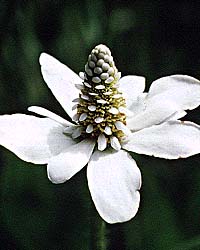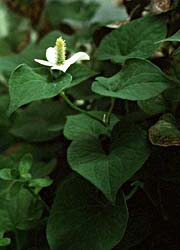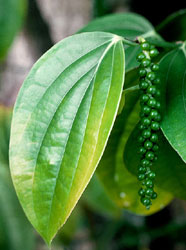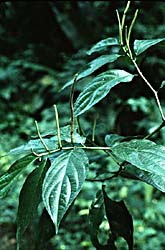 |
 |
The Piperales are a group of herbs, shrubs, and small trees found primarily in the tropics. Many species are aromatic, producing fragrant or spicy smells.
A common characteristic of the members of this group are the flower clusters. Rather than having large, showy flowers, the Piperales have tiny flowers that have no petals at all; the miniscule flowers are densely clustered in long spikes. In some species, the flowers closest to the bottom produce large petal-like bracts, so that the whole cluster resembles an odd flower, as in Anemopsis, shown below.
 |
 |
Saururaceae : Species placed in the lizard's tail family have showy bracts associated with some of their flowers. At left, a closeup of the "flower" from Anemopsis californica reveals that it is really a stalk packed with numerous tiny flowers and bracts. At right, a picture of Houttuynia cordata, showing its large heart-shaped leaves.
The Piperales are usually divided into two unequal groups. The first is the Saururaceae, including 5 genera and seven species from North America and eastern Asia. These are the species with petaloid bracts, such as those pictured above.
The second group is the Piperaceae with more than 1400 species, mostly in the genera Piper and Peperomia. This group occurs throughout the tropics in shady habitats, though some species are fleshy and succulent, growing in seasonally dry habitats or on rock faces. Members of the Piperaceae are often raised as houseplants, for spices, or as a narcotic chew.
 |
 |
Piperaceae : The most economically important species of Piperales is Piper nigrum, shown above at left. The berries from this plant are harvested to make black pepper, one of the world's most popular spices. At right is another species of Piper, photographed in Vera Cruz, Mexico.
Strangely, the Piperales do not seem to have any reported fossil record, either as pollen or as organ fossils. However, their close relatives Aristolochiales and Nymphaeales both appear in the Cretaceous.
Visit the Tree of Life for current views on the relationships of the Piperales.


